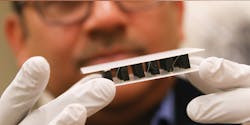Temperature Changes Could Power Buildings
For decades, researchers have been searching for a way to produce electricity that is neither toxic nor expensive. A recent discovery comprising a chemical combination of calcium, cobalt and terbium was found to create an efficient, inexpensive and bio-friendly material that could solve energy shortages and price volatility worldwide.
The new material, composed by a team of engineers at the University of Utah led by Professor Ashutosh Tiwari, can be applied to jewelry or other materials. When body heat warms it up, the new alloy generates enough electricity to charge a cell phone or power a cooking pan through a thermoelectric process involving cold and hot air.
The thermoelectric effect occurs when one end of the material is hot and the other end is cold. Charge carriers from the hot end move through the material to the cold end, generating an electrical voltage. The material needs less than a 1 degree F. difference in temperature to produce a detectable voltage.
The potential applications for the new material are limitless, says Tiwari. The range of applications include operating a heart monitor with jewelry, lowering the amount of energy buildings must buy from the grid, generating extra power for an airplane from heat inside the cabin and creating electricity for energy-scarce homes in developing countries.
The Technology & Venture Commercial-ization Office of the University of Utah filed a patent for the material. The team will initially develop it for biosensors and for use in cars.
